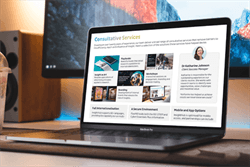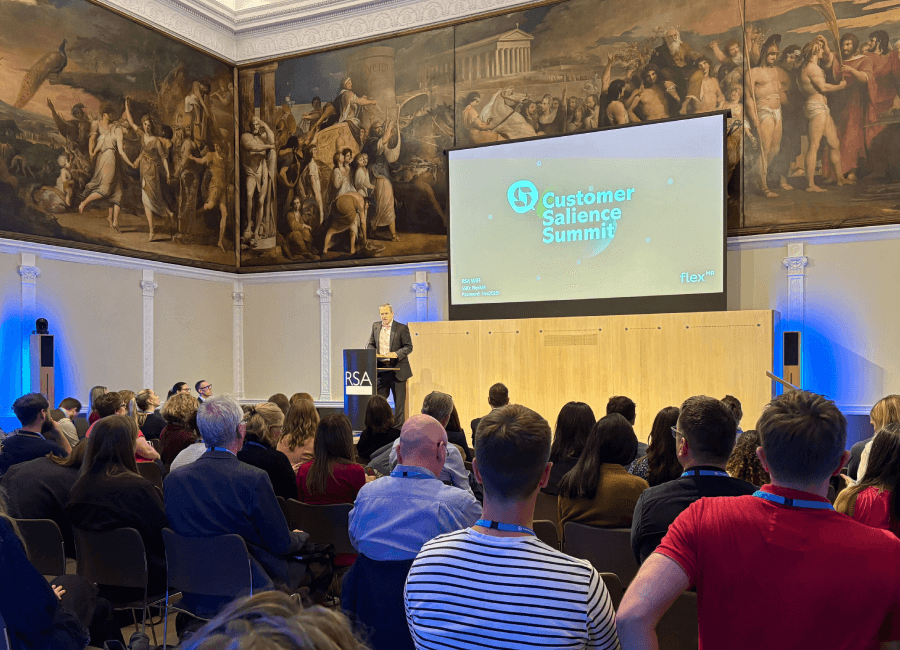In today’s rapidly evolving marketplace, businesses from all sectors are increasingly recognizing the paramount importance of placing the customer at the heart of their operations. This strategic orientation, known as customer centricity, is not merely a buzzword but a fundamental shift in how companies engage with their clientele. For market researchers, understanding and implementing customer-centric principles is essential to drive meaningful insights and foster business growth.
This comprehensive guide delves into the essence of customer centricity, its significance, strategies for development, and the challenges faced, offering actionable solutions to navigate this transformative journey. Additionally, we explore real-world examples, emerging trends, and future considerations that can help businesses stay ahead in the customer-centric landscape.
What is Customer Centricity?
In short, customer centricity is a business philosophy that prioritizes the customer’s needs, preferences, and experiences in every decision and strategy. It involves a deep commitment to understanding customers on an individual level and delivering personalized solutions that not only meet but exceed their expectations. This approach transcends traditional customer service, embedding a customer-first mindset across all facets of an organization, from product development and marketing to sales and after-sales support.
Here are a few of the key features that differentiate customer centric businesses and the cultures that they inspire.
Deep Understanding of Customer Needs
Investing in comprehensive research and advanced analytics is crucial to gaining a profound understanding of customer behaviours, preferences, and pain points. This involves not only collecting quantitative data through surveys and market analysis but also delving into qualitative insights by engaging directly with customers through interviews, focus groups, and social listening.
By employing sophisticated data analytics tools, businesses can identify patterns and trends that reveal the underlying motivations and desires of their customers. This deep dive into customer psychology enables companies to anticipate needs, tailor their offerings, and create personalised experiences that resonate on an emotional level. Furthermore, by continuously monitoring and analysing customer feedback, businesses can adapt swiftly to changing preferences, ensuring they remain relevant and competitive in a dynamic marketplace.
Personalised Customer Experiences
In today's competitive market, businesses are increasingly focusing on tailoring products, services, and interactions to meet the unique needs and preferences of individual customer profiles. This involves leveraging advanced data analytics and customer insights to create bespoke experiences that resonate on a personal level. By understanding the specific desires, behaviours, and pain points of each customer, companies can offer customised solutions that not only address immediate needs but also anticipate future demands.
This level of personalisation extends beyond mere product recommendations; it encompasses every touchpoint in the customer journey, from personalised marketing messages and tailored service interactions to bespoke product offerings and exclusive loyalty rewards. By doing so, businesses can foster deeper connections with their customers, enhance satisfaction, and build long-lasting relationships that drive loyalty and advocacy.
Customer Feedback Loops
Regularly collecting and acting upon customer feedback is crucial for driving continuous improvement within an organisation. This process involves systematically gathering insights from customers through various channels such as surveys, online reviews, social media interactions, and direct communication. By actively listening to customer opinions and experiences, businesses can identify areas for enhancement and innovation. Once feedback is collected, it is essential to analyse the data to uncover patterns and trends that highlight customer needs and expectations.
Acting on this feedback requires implementing changes and adjustments to products, services, and processes, ensuring that customer concerns are addressed promptly and effectively. Furthermore, establishing a robust feedback loop means continuously revisiting and refining strategies based on new insights, fostering a culture of adaptability and responsiveness. This ongoing dialogue with customers not only enhances satisfaction and loyalty but also positions the company to anticipate future demands and maintain a competitive edge in the marketplace.
Cross-Functional Collaboration
Ensuring all departments work cohesively to enhance the customer experience involves fostering a culture of open communication and shared goals across the entire organisation. This means breaking down silos between departments such as marketing, sales, product development, and customer service, to create a seamless flow of information and insights.
| Tweet This | |
| Stakeholders everywhere talk about the importance of customer satisfaction and designing the right experience, but where does customer centricity fit into all of that? |
By encouraging regular inter-departmental meetings and collaborative projects, businesses can ensure that every team is aligned with the overarching objective of delivering exceptional customer experiences. This collaborative approach not only helps in identifying and addressing customer pain points more effectively but also promotes innovation by leveraging diverse perspectives and expertise. Additionally, it empowers employees to contribute to customer-centric strategies, ensuring that every decision made is informed by a comprehensive understanding of customer needs and expectations.
Empowered Employees
Providing staff with the necessary tools, resources, and authority is crucial for enabling them to make informed, customer-focused decisions. This empowerment involves equipping employees with comprehensive training, access to relevant data, and the autonomy to address customer needs effectively and efficiently. By fostering a supportive environment where employees feel confident and capable of taking initiative, businesses can ensure that their teams are well-prepared to deliver exceptional customer service.
This approach not only enhances employee satisfaction and engagement but also contributes to a more agile and responsive organisation, capable of adapting to customer demands and market changes swiftly. Empowered employees are more likely to take ownership of their roles, leading to innovative solutions and a stronger alignment with the company’s customer-centric goals.
Proactive Problem Solving
This involves a forward-thinking approach where businesses actively anticipate potential issues and challenges that could arise in the customer journey, addressing them before they have a chance to negatively impact the customer experience. By employing predictive analytics and regularly reviewing customer feedback, companies can identify patterns and potential pain points early on.
This proactive stance allows businesses to implement preemptive measures, such as refining processes, enhancing product features, or improving service protocols, to mitigate risks and ensure a seamless customer experience. Additionally, fostering a culture of innovation and continuous improvement within the organisation empowers teams to think creatively and develop solutions that not only resolve current issues but also prevent future ones. This approach not only enhances customer satisfaction and loyalty but also positions the company as a reliable and trustworthy partner in the eyes of its clientele.
Long-Term Relationship Building
In the realm of customer centricity, prioritising long-term relationship building is essential for sustainable business success. This involves a strategic focus on nurturing customer retention and fostering loyalty, rather than merely chasing short-term gains. By cultivating enduring relationships, businesses can create a loyal customer base that not only returns for repeat purchases but also becomes advocates for the brand.
Such an approach requires a deep understanding of customer needs and preferences, allowing companies to deliver consistent value and personalised experiences that resonate over time. Implementing loyalty programmes, maintaining regular and meaningful engagement, and providing exceptional service are key components in this strategy. By investing in long-term relationships, businesses can ensure a stable revenue stream, enhance customer satisfaction, and ultimately achieve a competitive advantage in the marketplace.
Adaptability & Flexibility
In the ever-changing landscape of modern business, the ability to be responsive to evolving customer needs and shifting market dynamics is crucial for maintaining a competitive edge. This involves not only recognising and understanding the subtle shifts in consumer preferences and behaviours but also having the agility to adjust strategies, products, and services accordingly.
Companies must cultivate a culture that embraces change, encouraging innovation and creative problem-solving to swiftly address new challenges and opportunities. By fostering an environment where adaptability and flexibility are core values, businesses can ensure they remain relevant and resilient, capable of meeting the demands of a dynamic marketplace while continuing to deliver exceptional customer experiences.
Transparent Communication
Maintaining honesty and clarity in all customer interactions is essential for building trust and fostering strong relationships. This involves being open about company policies, product details, and any changes that may affect the customer experience. By ensuring that all communications are straightforward and truthful, businesses can prevent misunderstandings and manage customer expectations effectively.
Transparent communication also means being proactive in addressing any issues or concerns, providing timely updates, and being accessible for customer inquiries. This approach not only enhances customer satisfaction but also positions the company as a reliable and trustworthy partner, encouraging loyalty and advocacy in the long run.
Benefits of Customer Centricity
By aligning products and services with customer expectations, businesses can foster higher satisfaction levels, leading to increased loyalty and repeat business. Studies show that companies with high customer satisfaction ratings enjoy stronger retention rates and brand advocacy. But that’s not the only important benefit. Here’s a few others to consider:
Competitive Differentiation
In markets saturated with similar offerings, a customer-centric approach serves as a key differentiator, setting a brand apart through exceptional customer experiences. Companies like Amazon and Apple have excelled by prioritizing the customer journey and ensuring seamless interactions across multiple touchpoints.
Increased Customer Lifetime Value (CLV)
Satisfied customers are more likely to engage in repeat purchases and explore additional offerings, thereby enhancing their overall lifetime value to the business. Customer-centric firms enjoy higher average revenue per user (ARPU) and lower churn rates.
Positive Word-of-Mouth and Referrals
Delighted customers often become brand advocates, sharing their positive experiences and attracting new clientele through organic referrals. With social media and online reviews playing a crucial role in purchasing decisions, word-of-mouth marketing has never been more influential.
Improved Product and Service Innovation
A deep understanding of customer needs fuels innovation, enabling companies to develop offerings that resonate with their target audience. Firms that incorporate customer feedback into product development cycles achieve higher success rates with new launches.
Operational Efficiency
Focusing on customer-centric processes helps identify and eliminate inefficiencies, leading to streamlined operations and cost savings. Businesses that align their operations with customer needs often experience reduced support inquiries and higher satisfaction levels.
Stronger Financial Performance
Collectively, these advantages contribute to robust financial health, driven by sustained revenue streams and prudent resource allocation. McKinsey reports indicate that customer-centric companies outperform competitors by up to 60% in profitability.
Developing a Customer-Centric Culture
Transitioning to a customer-centric organization requires deliberate strategies and a cultural shift that permeates every level of the business.
- Cultivate a Customer-Centric Mindset – Leadership must champion and model a customer-first philosophy, embedding it into the company’s mission, values, and goals.
- Invest in Customer Insights and Analytics – Utilize advanced analytics tools to gather and interpret data on customer behaviors, preferences, and feedback, transforming insights into actionable strategies.
- Personalize Customer Interactions – Leverage data to tailor communications, recommendations, and services, creating a personalized experience that resonates with individual customers.
- Foster Cross-Departmental Collaboration – Encourage seamless communication and collaboration among departments to ensure a unified approach to customer engagement.
- Empower Employees – Provide training and resources that enable employees to make informed, customer-focused decisions, fostering a sense of ownership and accountability.
- Implement Robust Feedback Mechanisms – Establish channels for customers to share their experiences and ensure feedback is systematically analyzed and acted upon.
- Prioritize Long-Term Relationships – Shift focus from transactional interactions to building enduring relationships through loyalty programs, consistent engagement, and exceptional service.
- Maintain Agility and Adaptability – Stay attuned to market trends and be willing to adapt strategies to meet evolving customer needs and expectations.
- Ensure Transparent and Honest Communication – Build trust by being open about company policies, product information, and any changes that may affect customers.
- Commit to Continuous Improvement – Regularly assess and refine customer-centric practices, embracing innovation and seeking opportunities to enhance the customer experience.
Challenges to Achieving Customer Centricity
Certainly, achieving customer-centricity is not without its hurdles. Businesses often encounter a myriad of challenges that can complicate the journey towards placing the customer at the core of their operations. These challenges can stem from various sources, including internal organisational resistance, where entrenched practices and mindsets may hinder the adoption of a customer-first approach.
| Tweet This | |
| Becoming customer-centric from an organisation-centric business is tough, and there are a few mistakes these stakeholders are likely to fall prey to... |
Additionally, the fragmentation of data across different departments can obstruct a comprehensive understanding of customer needs and behaviours, making it difficult to deliver personalised experiences. Furthermore, measuring the success of customer-centric initiatives can be complex, as it requires the establishment of clear and relevant key performance indicators (KPIs) that accurately reflect customer satisfaction and engagement.
Overcoming these obstacles demands a strategic and concerted effort, involving cultural shifts, technological integration, and a commitment to continuous improvement. Here's a few key challenges and solutions.
Overcoming Internal Resistance
Many organizations encounter significant challenges with cultural resistance when attempting to transition towards a customer-centric model. This resistance often stems from deeply ingrained traditional practices and mindsets that are focused on product or profit rather than the customer. Employees may be accustomed to established routines and may view the shift as a threat to their roles or as an unnecessary change. To effectively combat this resistance, businesses should take a multi-faceted approach. Firstly, it is crucial to clearly communicate and emphasise the long-term benefits of adopting a customer-centric approach, such as increased customer loyalty, improved brand reputation, and enhanced financial performance.
By illustrating how these benefits contribute to the overall success and sustainability of the organisation, employees can better understand the value of the transition. Additionally, involving employees in the strategy development process is essential. This inclusion not only fosters a sense of ownership and accountability but also encourages employees to contribute their insights and ideas, which can lead to more innovative and effective customer-centric strategies.
Furthermore, providing comprehensive training programs is vital to equip employees with the necessary skills and knowledge to adapt to new customer-focused practices. These programs should focus on developing a deep understanding of customer needs, effective communication skills, and the use of data analytics tools to personalise customer interactions. By investing in employee development and creating an inclusive environment, organisations can gradually shift the internal culture towards one that embraces and champions customer centricity.
Breaking Down Data Silos
Data fragmentation often impedes a holistic view of the customer, creating significant challenges for businesses striving to deliver personalised and seamless experiences. This fragmentation occurs when customer data is scattered across various departments and systems, leading to disjointed insights and an incomplete understanding of customer behaviours and preferences.
To overcome this barrier, companies must prioritise the integration of customer data across all touchpoints, ensuring that every interaction, whether online or offline, contributes to a comprehensive customer profile. This can be achieved by implementing robust Customer Relationship Management (CRM) platforms that centralise data collection and management, allowing for a unified view of the customer journey.
Additionally, leveraging AI-driven analytics is crucial for processing and analysing vast amounts of data, uncovering patterns, and generating actionable insights. By harnessing these advanced technologies, businesses can not only streamline operations but also enhance their ability to anticipate customer needs, tailor offerings, and ultimately foster stronger, more meaningful relationships with their clientele.
Measuring Success
Defining clear Key Performance Indicators (KPIs), such as Net Promoter Score (NPS), Customer Satisfaction Score (CSAT), and Customer Lifetime Value (CLV), is crucial for businesses aiming to effectively measure their progress and refine their strategies for improved outcomes. NPS provides insights into customer loyalty by gauging the likelihood of customers recommending the company to others, while CSAT measures the level of satisfaction customers feel after interacting with a product or service.
CLV, on the other hand, helps businesses understand the total revenue they can expect from a customer over the entire duration of their relationship. By establishing these KPIs, companies can track their performance in real-time, identify areas needing improvement, and make data-driven decisions that enhance customer experiences and drive business growth. Furthermore, regularly reviewing and adjusting these KPIs ensures that they remain aligned with evolving business goals and market conditions, ultimately leading to more effective and customer-focused strategies.
The Future of Customer Centricity
As technology advances and consumer expectations evolve, customer-centricity will continue to shape business strategies. Companies that embrace AI, predictive analytics, and hyper-personalization will be better positioned to meet customer needs proactively. Additionally, ethical considerations such as data privacy and sustainability will play an increasing role in fostering trust and loyalty.
Businesses that successfully implement customer-centric strategies will not only enhance customer satisfaction and retention but also drive innovation, operational efficiency, and long-term profitability.
In short, customer centricity is no longer an option. It is a necessity in today’s dynamic business landscape. By prioritizing customer needs, fostering a culture of continuous improvement, and leveraging data-driven insights, businesses can create lasting relationships and gain a competitive edge. While challenges exist, proactive solutions and a commitment to customer-first strategies will ensure long-term success in an ever-evolving marketplace.


















